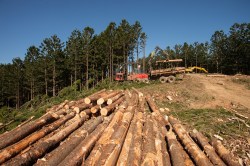
ShutterstockiPhone chargers in waiting.
Follow this if you can: Wood from U.S. trees is being shipped over to the U.K., where coal power plants burn it, producing more greenhouse gas emissions than when those same plants generate an equivalent amount of electricity by burning coal.
The weirdest part? This doubly destructive practice is being subsidized in the U.K. to help the country meet its renewable energy targets. WTF?
The BBC explains that when pine trees are grown in America, the best trunks are cut up for wood planks and sold as timber. Much of the rest of the wood is either used for wood pulp or gets chopped up to be used as fuel. Because the wood chips are considered a renewable energy source by the British government, great piles are being shipped over to England to be burned.
“It is the massive scale of this operation that so alarms environmentalists,” BBC environment reporter Roger Harrabin said in a segment aired Tuesday. “Environmentalists say it is madness to be growing trees in the U.S.A. to be keeping the lights on in Britain. But this industy is helping the U.K. meet its targets on renewable energy.”
From a recent article in Power Engineering International:
In November 2012, the UK’s Royal Society for the Protection of Birds (RSPB), Friends of the Earth and Greenpeace called on the UK government to cancel plans to subsidise the burning of trees in coal power stations. The RSPB report ‘Dirtier Than Coal?’ says that generating power from typical conifer trees results in 49 per cent more emissions than burning coal, and calls on the government to withdraw public subsidy for generating from feedstock derived from tree trunks.
Biomass generation is booming on the back of climate change legislation and incentives. …
These differ from country to country. As the sector becomes better developed, sophisticated distinctions may have to be built in to encourage the use of biomass that is environmentally and economically sustainable with an acceptable carbon payback period.
In May 2010 the US Environmental Protection Agency decided to include greenhouse gas emissions from biomass energy in its greenhouse gas permit programme. This would treat CO2 emissions from biomass generation and fossil fuels equally. But successful lobbying by the forestry industry led the EPA to defer implementation for three years while it considers how biomass emissions should be determined.
Burning trees for electricity certainly gives new meaning to the term “green energy” — insomuch as it isn’t green at all. Well, I suppose the trees were once green? I guess they’ve got us there.



